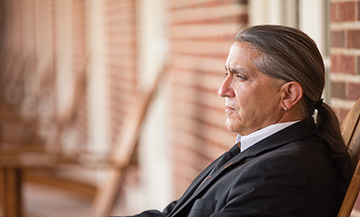Leveling the Field
Thursday, January 29, 2015
John Chaney’s AIIP program gives Native American students stronger shot at success
“I always knew that I would want to find a way to contribute back to Native people.”

In 1997, John Chaney, Regents professor of psychology, launched the American Indians Into Psychology (AIIP) program at Oklahoma State University with the aid of a federal grant. Last fall, the Indian Health Services awarded OSU a $1.2 million grant to continue AIIP for another five years.
The AIIP is a unique opportunity for Native American students interested in psychology careers. It quickly blossomed in the late ’90s and has become a well-oiled machine at OSU thanks to a collaborative — and largely volunteer — spirit within the Department of Psychology. The program’s success is one reason OSU graduates the most Native American psychology doctoral students in the country.
Of course, its success took more than just financial backing.
“Just throwing money at the problem isn’t the answer,” Chaney says. “Preparing and giving them the mentoring experience that most students — but especially Indian students — don’t have levels the playing field.”
The AIIP at OSU works in two way: first, through graduate and undergraduate scholarships, and second, via an intensive summer enrichment program, which draws students from all over the country. Acceptance into the summer program is highly competitive and richly rewarding for those who attend.
“From the very beginning, it was geared toward making you successful,” says Evan White, a current OSU graduate student in psychology. White applied for the program his junior year and soon after his acceptance, he received a surprising phone call. An undergraduate mentor at OSU reached out to him to make sure he knew what to expect when he arrived.
Such proactive assistance flows from the faculty to the graduate students to the undergraduates. Those who have succeeded in the program often later volunteer their time and expertise to AIIP. Clinical psychology graduate student Victoria O’Keefe, who identifies with both the Cherokee and Seminole tribes, says this across-the-board collaboration makes OSU’s program stand out.
“What was unique was I got a lot of information about how to get into graduate school from faculty and current graduate students, and I think getting that feedback definitely helped,” O’Keefe says.
The AIIP Summer Enrichment Program is an intensive, five-week primer covering everything a student might need to know about succeeding as a researcher and how to prepare for graduate school. Many are accepted into graduate school at OSU, though that is not a requirement of the summer program nor does participation guarantee a student will be accepted at OSU.
As the program’s prestige grows, competition heats up. Nearing its 20th year, the AIIP boasts an impressive list of graduates, including Tamara Newcomb, who serves as director of Behavioral Health Services for the Muscogee (Creek) Nation and on the AIIP advisory board. More than a decade removed from her time in the summer program, Newcomb credits the boot camp-style experience with shaping her path.
“The program helped me understand what I wanted to do,” she says. “It gave me not only an experience of what tribal behavioral health looked like but also provided networking opportunities.”
Those opportunities include meeting representatives from various tribes around the state, which is an invaluable portion of the program. Other portions include directives on creating a curriculum vitae, guidance in studying for the GRE, teaching how to give a presentation, providing mock interviews and requiring a small research study. Essentially, after spending five weeks in Stillwater, participants in the program are well-groomed for success as researchers and supreme graduate school candidates.

The goal in producing well-trained students is to eventually provide top-notch mental health care to under-served American Indian communities. With that in mind, Chaney requires candidates for the program to show how they have stayed connected with their tribes. O’Keefe, for instance, has been a competitive powwow dancer since she was 5 years old. In fact, she was Head Lady Dancer at OSU’s Fall Contest Powwow two years ago.
“It’s your identity and your culture,” she says. “That was something my parents ingrained in me from a very young age.”
By drawing students from all over the country and many different tribes, participants in the AIIP summer program also have a chance to share their experiences and learn about others. White recalls during his turn in the summer program, one student from New Mexico had grown up on a reservation and was able to speak her native language.
“That type of cultural involvement was something we all benefited from,” he says.
The AIIP program has taken off at OSU because of interactions like that. Additionally, tremendous support from within the psychology department has greatly enriched the program. Faculty and graduate students volunteer their expertise. In fact, faculty members often ask Chaney about the candidates long before summer begins.
Story by Brian Petrotta
